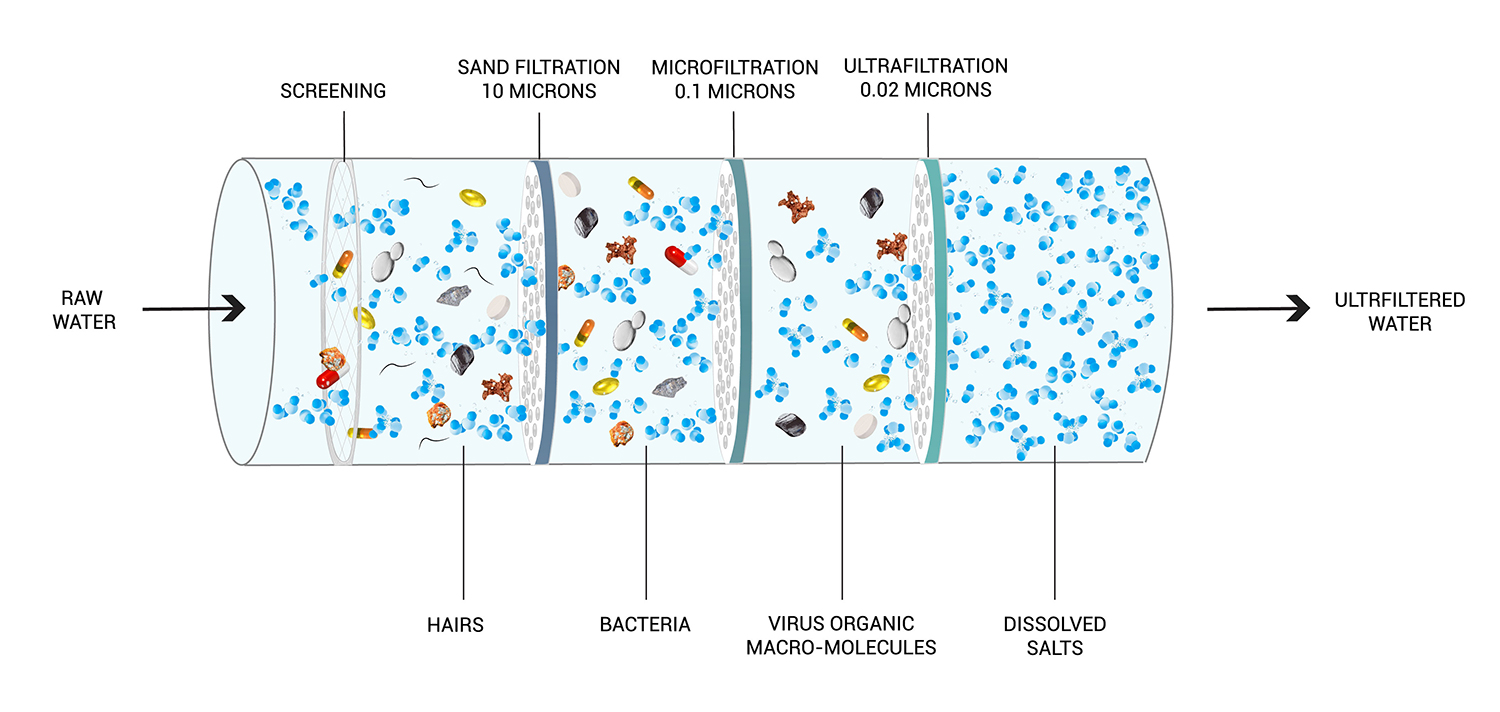Absolute VS Nominal Filters
Basics of waterborne diseases
Bubble point definition
Chemical adsorption of carbon
Granular activated carbon fact sheet
How do carbon filter work?
Water Softener – How do they work? – FAQs
What is a filter Beta Ratio
What is Osmosis and Reverse Osmosis
Water Glossary
What is Ultrafiltration
What is Ultraviolet water treatment?
Ultrafiltration physically separates solids from liquid streams based on the size-exclusion.

Ultrafiltration (UF) is a membrane filtration process similar to Reverse Osmosis which uses hydrostatic pressure to push water through a semi-permeable membrane. Ultrafiltration (UF) is a barrier driven by pressure to reduce or remove solids, bacteria, viruses, endotoxins and other pathogens to produce water with very high purity and low silt density.
Ultrafiltration (UF) is a type of membrane filtration in which hydrostatic pressure forces a liquid against a semi permeable membrane and suspended solids and solutes of high molecular weight are retained while water and low molecular weight solutes pass through the membrane. Ultrafiltration is not any different from reverse osmosis, microfiltration or nanofiltration, except in terms of the size of the molecules it retains.
A membrane or a semi permeable membrane, is a thin layer of material capable of separating substances when a driving force is applied across the membrane. Membrane processes are being increasingly employed for removal of bacteria and other microorganisms, particulate material, and natural organic material, which can impart color, tastes, and odors to the water and react with disinfectants to form disinfection byproducts (DBP).
Ultrafiltration (UF) removes essentially all colloidal particles (0.01 to 1.0 microns) from water and some of the largest dissolved contaminants. The pore size in a UF membrane is mainly responsible for determining the type and size of contaminants removed, the membrane pores range in size from 0.005 to 0.1 micron. UF membrane manufacturers classify each UF product as having a specific molecular weight cutoff (MWC), this is a rough measurement of the size of contaminants removed by a given UF membrane. A 100,000 MWC UF membrane means that when water containing a given standard compound with a molecular weight of around 100,000 daltons is fed to the UF unit, nearly most of the compound will not pass through the membrane. A substances with a molecular weight of 100,000 daltons has a size of about 0.05 microns to about 0.08 microns in diameter and are used where essentially all colloidal particles, including most pathogenic organisms must be removed.
HOW DOES ULTRAFILTRATION WORK?
Ultrafiltration uses hollow fibers of membrane material. The feed water flows either inside the shell, or in the lumen of the fibers. Suspended solids and solutes of high molecular weight are retained by the membrane, while water and low molecular weight solutes pass through. Ultrafiltration is not any different from reverse osmosis, microfiltration or nanofiltration, except in terms of the size of the molecules it contains. When strategically combined with other purification technologies in a complete water system, UF removes colloids, proteins, bacteria, pyrogens, proteins, and macromolecules larger than the membrane pore size from water.
BENEFITS
- Simple automation
- Environmentally friendly
- Process and plant compactness
- Size-exclusion filtration as opposed to media depth filtration
- No need for any chemicals (coagulants, flocculates, disinfectants, pH adjustment)
- Good and constant quality of the treated water regarding particle and microbial removal
WHAT DOES ULTRAFILTRATION REMOVE?
- Silt
- Silica
- Smog
- Viruses
- Plastics
- Proteins
- Endotoxins
MAINTENANCE
Ultrafiltration systems contain extremely fine membrane filters which need to be properly cleaned depending on whether its removing organic or inorganic contaminants. To remove organic contaminants the general tubular membrane cleaning protocol is to use a low foam, medium alkaline detergent at 0.6% to 1% for a maximum of 40 to 60 minutes. For removing inorganic contaminants, the best treatment is with citric acid at a maximum concentration of 3.0 % and should circulate for 1 to 3 hours. Hydrochloric acid can also be used to clean membranes, as can oxalic, sulfuric and nitric acid.
